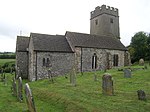St Peter's Church, Exton
Grade II* listed buildings in West SomersetGrade II* listed churches in SomersetScheduled monuments in West Somerset

The Anglican St Peter's Church at Exton within the English county of Somerset has a 13th-century tower and 15th century aisle. It is a Grade II* listed building.Some of the original Norman stonework can still be identified in the nave. The rest of the building has been reconstructed with the crenellated two-stage tower being added in the 13th century and the aisle in the 15th. It was restored and the chancel rebuilt in 1876.In the churchyard is a 14th-century cross with a tapering octagonal stone shaft. The upper part of the shaft was restored in 1875.The parish is within the Exmoor benefice and the archdeaconry of Taunton.
Excerpt from the Wikipedia article St Peter's Church, Exton (License: CC BY-SA 3.0, Authors, Images).St Peter's Church, Exton
Lype Lane,
Geographical coordinates (GPS) Address Nearby Places Show on map
Geographical coordinates (GPS)
| Latitude | Longitude |
|---|---|
| N 51.0925 ° | E -3.5352777777778 ° |
Address
Lype Lane
TA22 9JT , Exton
England, United Kingdom
Open on Google Maps







